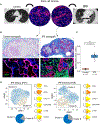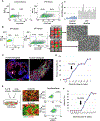Cloning a profibrotic stem cell variant in idiopathic pulmonary fibrosis
- PMID: 37099633
- PMCID: PMC10794039
- DOI: 10.1126/scitranslmed.abp9528
Cloning a profibrotic stem cell variant in idiopathic pulmonary fibrosis
Abstract
Idiopathic pulmonary fibrosis (IPF) is a progressive, irreversible, and rapidly fatal interstitial lung disease marked by the replacement of lung alveoli with dense fibrotic matrices. Although the mechanisms initiating IPF remain unclear, rare and common alleles of genes expressed in lung epithelia, combined with aging, contribute to the risk for this condition. Consistently, single-cell RNA sequencing (scRNA-seq) studies have identified lung basal cell heterogeneity in IPF that might be pathogenic. We used single-cell cloning technologies to generate "libraries" of basal stem cells from the distal lungs of 16 patients with IPF and 10 controls. We identified a major stem cell variant that was distinguished from normal stem cells by its ability to transform normal lung fibroblasts into pathogenic myofibroblasts in vitro and to activate and recruit myofibroblasts in clonal xenografts. This profibrotic stem cell variant, which was shown to preexist in low quantities in normal and even fetal lungs, expressed a broad network of genes implicated in organ fibrosis and showed overlap in gene expression with abnormal epithelial signatures identified in previously published scRNA-seq studies of IPF. Drug screens highlighted specific vulnerabilities of this profibrotic variant to inhibitors of epidermal growth factor and mammalian target of rapamycin signaling as prospective therapeutic targets. This profibrotic stem cell variant in IPF was distinct from recently identified profibrotic stem cell variants in chronic obstructive pulmonary disease and may extend the notion that inappropriate accrual of minor and preexisting stem cell variants contributes to chronic lung conditions.
Conflict of interest statement
Figures






References
-
- Lederer DJ, Martinez FJ, Idiopathic pulmonary fibrosis. N. Engl. J. Med. 379, 797–798 (2018). - PubMed
-
- Wolters PJ, Blackwell TS, Eickelberg O, Loyd JE, Kaminski N, Jenkins G, Maher TM, Molina-Molina M, Noble PW, Raghu G, Richeldi L, Schwarz MI, Selman M, Wuyts WA, Schwartz DA, Time for a change: Is idiopathic pulmonary fibrosis still idiopathic and only fibrotic? Lancet Respir. Med. 6, 154–160 (2018). - PMC - PubMed
-
- Selman M, Pardo A, The leading role of epithelial cells in the pathogenesis of idiopathic pulmonary fibrosis. Cell. Signal. 66, 109482 (2020). - PubMed
-
- Nogee LM, Dunbar III AE, Wert SE, Askin F, Hamvas A, Whitsett JA, A mutation in the surfactant protein C gene associated with familial interstitial lung disease. N. Engl. J. Med. 344, 573–579 (2001). - PubMed
-
- Selman M, Lin H-M, Montano M, Jenkins AL, Estrada A, Lin Z, Wang G, DiAngelo SL, Guo X, Umstead TM, Lang CM, Pardo A, Phelps DS, Floros J, Surfactant protein A and B genetic variants predispose to idiopathic pulmonary fibrosis. Hum. Genet. 113, 542–550 (2003). - PubMed
Publication types
MeSH terms
Grants and funding
- R01 CA272906/CA/NCI NIH HHS/United States
- R01 HL149678/HL/NHLBI NIH HHS/United States
- R01 DK115445/DK/NIDDK NIH HHS/United States
- U24 CA228550/CA/NCI NIH HHS/United States
- I01 BX005295/BX/BLRD VA/United States
- R01 HL157100/HL/NHLBI NIH HHS/United States
- P30 DK054759/DK/NIDDK NIH HHS/United States
- R01 DK047967/DK/NIDDK NIH HHS/United States
- P01 HL108808/HL/NHLBI NIH HHS/United States
- CRUK_/Cancer Research UK/United Kingdom
- R01 CA241600/CA/NCI NIH HHS/United States
- R01 HL136370/HL/NHLBI NIH HHS/United States
- R01 HL138510/HL/NHLBI NIH HHS/United States
- R01 HL165404/HL/NHLBI NIH HHS/United States
- P01 HL162607/HL/NHLBI NIH HHS/United States
- R01 HL129795/HL/NHLBI NIH HHS/United States
LinkOut - more resources
Full Text Sources
Other Literature Sources

